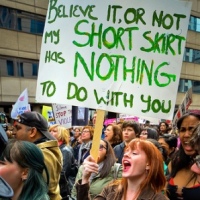Kathryn Bigelow, director of Zero Dark Thirty, the controversial account of the killing of Osama bin Laden by US Navy Seals in a CIA-led operation in Pakistan on May 2, 2011, has been described by feminist Naomi Wolf in The Guardian as “the handmaiden of evil,” and a successor to Germany’s notorious first female film director, Leni Riefenstahl.
Riefenstahl’s most famous work was the 1934 Triumph of the Will, regarded by many as an instrument of Nazi propaganda, as well as by others as a brilliant aesthetic and technical achievement.
It has not taken us long to arrive at Godwin’s Law.
The opening sequences of Bigelow’s movie portray torture, including waterboarding. This is carried out rather genially by the male CIA interrogator and witnessed by the film’s central character, Maya, a young female agent who has made it her mission to hunt down Osama bin Laden. Initially Maya struggles with her role as witness to inhumane cruelty, but she rapidly overcomes this squeamishness and enters into the zeitgeist. This depiction of Maya’s rapid moral disintegration from someone capable of discomfort in the face of torture to someone who wholeheartedly embraces the process, signifies early in the film the deadening and dehumanising effects of torture on its perpetrators.
Yet here, to me, is where critics of the film have confused the narration of events with apologia. Torture at that time was fully endorsed by the Bush administration, and renamed “enhanced interrogation techniques” in order to normalise the practice and make it publicly acceptable. Interrogators conducted their dark craft fully supported by their CIA masters, and their government. It is not Bigelow who endorses torture. It was the entire apparatus of the state. Bigelow is quite right, when she claims in her defence that her movie realistically depicts the situation that existed at the time, and depiction does not, and should not be assumed to, correlate with endorsement.
Not only do the scenes of torture provoke horror in the viewer, it seems that Bigelow’s refusal to take a moral position also provokes profound unease. How can she not use this opportunity to convey the absolute wrongness of the act? Why does she veer from the well-trodden path of traditional story telling, in which there is good and there is evil and the author has a point of view?
It’s true that if one stands by and allows certain events to take place, one can be held morally culpable. However, it is a different matter when one is narrating past events, and the climate in which they took place. At that time, the President of the United States encouraged his agents to torture. Do I really need anyone to spell out the horror of that for me? Has Bigelow failed me by not pointing this out in her film?
In declining to impose a moral vision, critics claim Bigelow has opted for what has been described as an “obscene neutrality.”
I am not sure that what Bigelow chooses is an “obscene neutrality” because I am not certain that neutrality in art is “obscene.” I think of The Sopranos, for example. Is David Chase similarly guilty of “obscene neutrality” because of his morally neutral depiction of the unspeakable violence repeatedly perpetrated by Tony Soprano and his mob? Is it not the creator’s privilege to refrain from expressing a moral viewpoint? Is it not an expression of the creator’s trust in her or his audience to thus refrain, and in so doing, respect the audience’s ability to think for itself without authorial imposition?
Is it inevitably the artist’s responsibility to take a moral perspective in her or his work, and if she fails to do this, can her work be described as “obscene?”
And why, out of all the unspeakable horrors wrought by human beings on one another, should torture be singled out as the one that must not be portrayed “neutrally?”
Slavoj Zizek writes in The Guardian that “to depict torture neutrally – ie to neutralise this shattering dimension – is already a kind of endorsement,” and goes on to say that “with torture one should not think.” Of course he is right in his call for a world in which the notion of torture is unthinkable, however, that is not the world in which we live. Given that torture remains a weapon of the state against its enemies, of course we must think about it, and of course it must be depicted in our art forms. Nobody ever changed or prevented anything by not thinking and not talking about it. That we must have this particular conversation is indeed indescribably sickening, but have it we must, otherwise there will be no opposition to torture. This is our reality. This is the reality Bigelow so bravely portrays. The critics are shooting the messenger.
I also find it difficult to agree with the description of the torture scenes as “neutral.” They were horrific and horribly confronting. I cannot find any way to interpret those scenes as “neutral,” and I cannot find anything in the film following those scenes that goes anywhere near “neutralising” them. I find it difficult to understand the mind set of a viewer who allows the impact of those scenes to be ameliorated by subsequent conversation and justification.
Indeed I would argue that Bigelow’s stark depiction of torture conveyed as nothing else could the abhorrent inhumanity of the practice. Nothing she did afterwards could erase that impression, indeed CIA justification only made things worse, as far as this viewer is concerned.
Bigelow seems to me to be a director who makes a conscious decision to withhold moral judgement, at least in her last two movies, The Hurt Locker & Zero Dark Thirty. The former, which is perhaps the most terrifying film I have ever seen, is told without embroidery of any kind: Bigelow embeds her audience with the bomb disposal squad on its tour of duty in Iraq, and leaves us to make of it what we will. In interviews she’s stated that “what we are attempting is almost a journalistic approach to film” and this approach is supremely successful in The Hurt Locker. Of course she is referring to journalism as it used to be, before it became opinion.
In Zero Dark Thirty there are later scenes in which Maya is warned that torture is no longer acceptable in the new administration of Barack Obama, indeed, television footage in the background shows Obama famously stating that America does not torture. It’s clear Maya may find herself held to account if she continues the practice, and the original genial interrogator quits in the nick of time and returns to Washington.
Critics claim Bigelow’s movie implies that torture led to the discovery of Bin Laden’s hideout. This is the CIA’s position, though it is increasingly contested within the organisation. The victim supplies his interrogator with a name, over a civilised post torture lunch, after he has been sufficiently broken. This name, together with a myriad of other intelligence, eventually leads the operatives to Bin Laden’s hideout.
Bigelow does not endorse or contest this sequence of events. In my opinion she does not need to, and I would not have welcomed a directorial intrusion at this point. It is obvious that the CIA would justify the use of torture exactly as Bigelow depicts. Bigelow is not inventing this story. She is telling it how it is.
Earlier torture scenes demonstrate the unreliability of information gained through inflicting pain, when the victim claims any of the week as the date for the next terrorist attack as he is forced, after waterboarding and other vile humiliations, curled foetal-like into a hideous box.
Bigelow made her film with extraordinary co-operation from the CIA. There is no doubt the story she tells is the CIA’s story, and indeed at this point there is no other story to tell. One day a Seal or a CIA operative may break ranks and reveal another point of view. It’s hardly likely the survivors of the attack on Bin Laden’s compound will have much to say, and who would believe them?
This has brought condemnation down on her, as if in the very telling of the CIA’s version of events she has inevitably aligned herself with that organisation and its methods. She should have deconstructed the CIA story, she should have critiqued their methods, she should have made another film altogether and by god she should have taken a moral stand, otherwise she is agreeing with it, or so some critics would have it. To me, as audience, I needed no authorial or directorial instruction on the morality of the CIA and its methods in this event. I wanted to know what was done at the time, and the justifications that were made in the context of the times. I didn’t need to know what Kathryn Bigelow felt about it.
I can see how Zero Dark Thirty can be interpreted as an apologia for torture. I believe that is a limited interpretation, and we need to push ourselves harder than that. I don’t believe for a moment that Bigelow intended to make a pro torture film. The director put a great deal of perhaps misplaced faith in her audience. She treated us with respect, and honoured our intelligence. She did not expect to have to tell us that the CIA’s story is horrifyingly flawed, she expected us to recognise that.
It is not Kathryn Bigelow who is the apologist for torture. It was the Bush administration, the CIA and the revenge society that sought to kill bin Laden, rather than arrest him and publicly try him for his crimes. In focussing on Bigelow, the bigger issues are lost. She is the chronicler of the times, not the advocate.





































Recent Comments